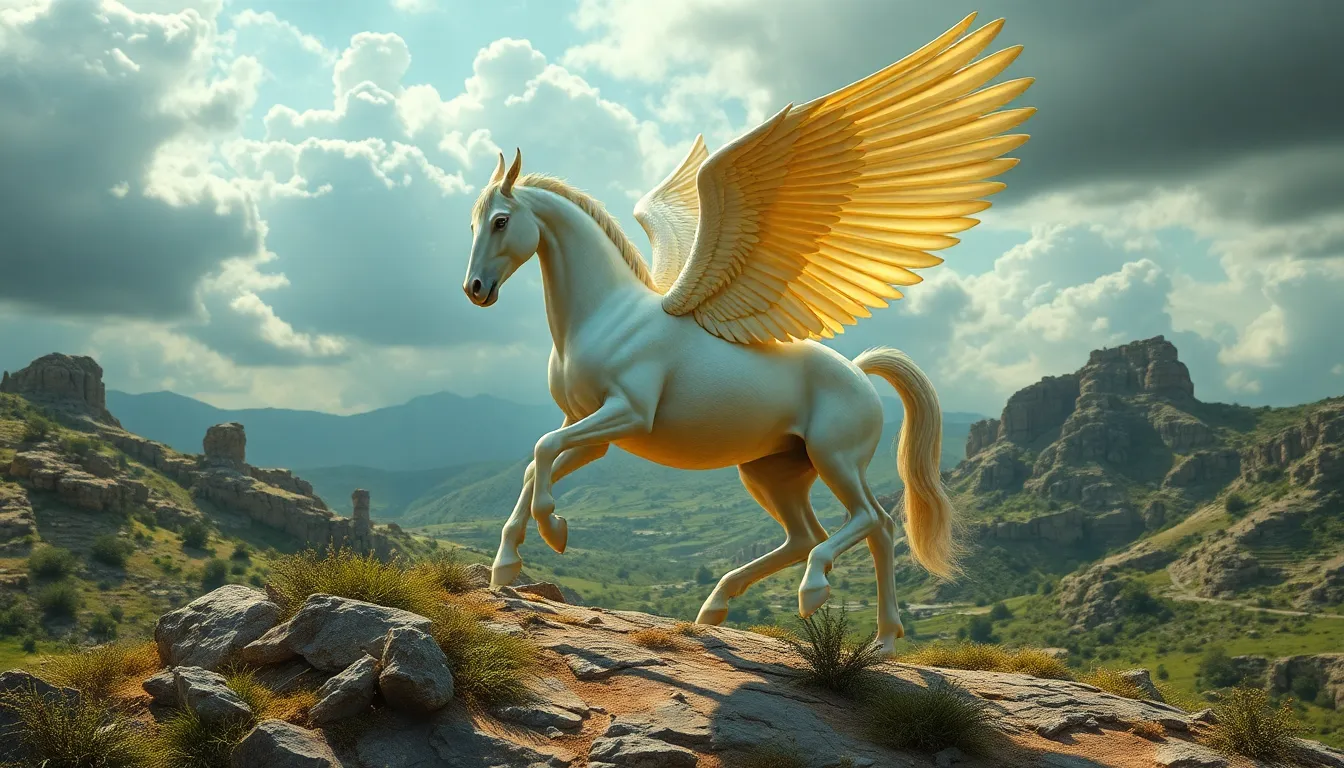The Mythological Geography of Pegasus: Where the Stories Take Place
I. Introduction to Pegasus in Mythology
Pegasus, the magnificent winged horse of Greek mythology, is a figure that has captivated imaginations for centuries. His stories intertwine with some of the most significant myths in the ancient world, representing themes of inspiration, heroism, and transformation.
The geographical settings in which these stories unfold play a crucial role in understanding the cultural significance and symbolism of Pegasus. This article explores the various locations associated with Pegasus, highlighting how these places contribute to his mythological narrative.
II. Origins of Pegasus: The Birthplace of a Legend
Pegasus’s origins are as dramatic as his later adventures. He was born from the blood of Medusa, one of the three Gorgons, when she was slain by the hero Perseus. This event took place in the dark, fearsome lair of the Gorgons, located at the edge of the known world.
The geographic significance of Medusa’s lair is profound. It symbolizes the intersection of chaos and creation, as Pegasus emerged from a place of horror to become a creature of beauty and inspiration. This duality is a recurring theme in his mythological journey, reflecting the complexities of his character.
III. Mount Helicon: The Sacred Realm of the Muses
Mount Helicon, a mountain in Boeotia, holds a special place in Greek mythology as the home of the Muses, the goddesses of inspiration in the arts and sciences. This sacred realm represents a source of poetic inspiration and creativity.
Pegasus’s connection to the Muses is particularly significant. It is said that he struck the ground with his hoof at Helicon, creating the spring Hippocrene, which became a source of divine inspiration for poets and artists alike. The artistic depictions of Pegasus at Helicon often showcase him as a symbol of the creative spirit, soaring above the mundane world to inspire greatness.
IV. The Springs of Hippocrene: A Symbol of Inspiration
The story of Hippocrene’s creation is steeped in mythological significance. After Pegasus created this spring, it became a cherished symbol of inspiration for poets. It is often described as a fountain of clear, sparkling water that could grant artistic abilities to those who drank from it.
The geographic significance of Hippocrene lies in its association with Helicon and the Muses. It represents the physical manifestation of inspiration, bridging the earthly and the divine. The cultural impact of Hippocrene is profound, as it has been referenced in numerous literary works and artistic creations, underscoring the enduring legacy of Pegasus as a muse.
V. The Role of Pegasus in the Trojan War
The Trojan War, one of the most famous conflicts in Greek mythology, provides a dramatic backdrop for Pegasus’s adventures. The geographic context of the war, with its cities and battlegrounds, plays a significant role in the narrative.
Pegasus’s involvement in the Trojan War is primarily through his association with the hero Bellerophon, who rode Pegasus in his quest to defeat the monstrous Chimera. The locations of this conflict, from the walls of Troy to the plains of Ilium, shape the stories of valor and heroism surrounding Pegasus.
The geographical elements of the Trojan War enrich the narrative, illustrating how Pegasus navigated both the physical landscape and the challenges of heroism.
VI. The Celestial Journey: Pegasus in the Night Sky
As we transition from the earthly realms of Greek mythology, Pegasus’s story takes to the stars. His myth transforms into a celestial narrative as he becomes a constellation, symbolizing the enduring legacy of his character.
The myth of Pegasus as a constellation is a fascinating aspect of his story. He is depicted soaring across the night sky, a reminder of his divine origins and his role as a symbol of inspiration. Various cultures have interpreted Pegasus in different ways, often seeing him as a representation of freedom, grace, and creativity.
VII. Modern Interpretations and Representations
In contemporary literature and media, Pegasus continues to be a powerful figure. His image has been reimagined in various forms, from children’s books to blockbuster films, showcasing his versatility as a symbol of inspiration and adventure.
Modern interpretations of Pegasus often explore themes of transformation and the quest for creativity. Artists and writers have found new ways to connect his mythological geography with contemporary issues, reflecting the ongoing influence of his legacy.
- In literature, Pegasus often represents the struggle between the mundane and the extraordinary.
- In visual arts, Pegasus is frequently depicted in dynamic poses, emphasizing his freedom and beauty.
- In popular culture, Pegasus appears in various forms, from video games to fashion, showcasing his timeless appeal.
VIII. Conclusion: The Legacy of Pegasus’s Mythological Geography
The geographical locations associated with Pegasus—from the lair of Medusa to the heights of Mount Helicon and the celestial realms—are integral to understanding his mythological significance. Each place contributes to the richness of his story, illustrating how geography shapes mythology.
The enduring legacy of Pegasus in both ancient and modern contexts highlights the importance of these geographical settings in myth and culture. They serve as a canvas upon which the stories of heroism, inspiration, and creativity are painted, reminding us of the power of mythology to transcend time and space.
In reflecting on how geography shapes our understanding of mythology, we recognize that the stories of figures like Pegasus are deeply rooted in the landscapes of their origins, influencing how they are perceived and celebrated in cultures around the world.




